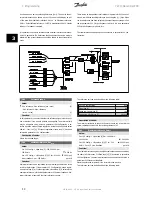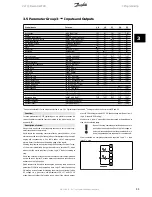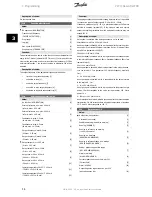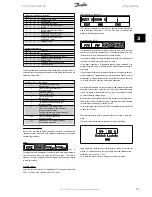
Latched start
, if a pulse is applied for min. 14 ms, the frequency converter
will start the motor, provided no stop command has been given. The mo-
tor can be stopped by briefly activating
Stop inverse
.
Reversing
is used for changing the direction of rotation of the motor shaft.
Logic '0' will not lead to reversing. Logic '1' will lead to reversing. The
reverse signal only changes the direction of rotation, it does not activate
the start. Is not active at
Process regulation, closed loop
. See also pa-
rameter 200
Output frequency range/direction
.
Reversing and start
is used for start/stop and for reversing with the same
signal. No active start command is allowed at the same time. Is not active
for
Process regulation, closed loop
. See also parameter 200
Output fre-
quency range/direction
.
Start clockwise
is used if you want the motor shaft only to be able to
rotate clockwise when started. Should not be used for
Process regulation,
closed loop
.
Start anticlockwise
is used if you want the motor shaft only to be able to
rotate anticlockwise when started. Should not be used for
Process regu-
lation, closed loop
. See also parameter 200
Output frequency range/
direction
.
Jog is used to override the output frequency to the jog frequency set in
parameter 213
Jog frequency
. Jog is active regardless of whether a start
command has been given, yet not when
Coast stop
,
Quick-stop
or
DC
braking
are active.
Freeze reference
freezes the present reference. The reference can now
only be changed via
Speed up
and
Speed down
. If
freeze reference
is
active, it will be saved after a stop command and in the event of mains
failure.
Freeze output
freezes the present output frequency (in Hz). The output
frequency can now only be changed via
Speed up
and
Speed down
.
NB!
If
Freeze output
is active the frequency converter can
only be stopped if you select
Motor coast
,
Quick stop
or
DC braking
via a digital input.
Speed up
and
Speed down
are selected if digital control of the up/down
speed is required. This function is only active if
Freeze reference
or
Freeze
output frequency
has been selected.
If
Speed up
is active the reference or output frequency will be increased,
and if
Speed down
is active the reference or output frequency will be
reduced. The output frequency is changed via the preset ramp times in
parameters 209-210
Ramp 2
.
One pulse (logic '1' minimum high for 14 ms and a minimum break time
of 14 ms) will lead to a speed change of 0.1 % (reference) or 0.1 Hz
(output frequency). Example:
Term.
29
Term.
33
Freeze ref/freeze
outp.
Function
0
0
1
No speed change
0
1
1
Speed up
1
0
1
Speed down
1
1
1
Speed down
Freeze reference
can be changed even if the frequency converter has
stopped. The reference will also be saved if the mains are disconnected
Catch-up/Slow-down
is selected if the reference value is to be increased
or reduced by a programmable percentage value set in parameter 219
Catch-up/Slow-down reference
.
Slow-down
Catch-up
Function
0
0
Unchanged speed
0
1
Increase by % value
1
0
Reduce by % value
1
1
Reduce by % value
Ramp 2
is selected if a shift between ramp 1 (parameters 207-208) and
ramp 2 (parameters 209-210) is required. Logic '0' leads to ramp 1 and
logic '1' leads to ramp 2.
Preset reference, lsb
and
Preset reference, msb
makes it possible to select
one of the four preset references, see the table below:
Preset ref.
msb
Preset ref.
lsb
Function
0
0
Preset ref. 1
0
1
Preset ref. 2
1
0
Preset ref. 3
1
1
Preset ref. 4
Preset reference on
is used for shifting between remote-controlled ref-
erence and preset reference. It is assumed that External/preset [2] has
been selected in parameter 214
Reference function
. Logic '0' = remote-
controlled references are active, logic '1' = one of the four preset refer-
ences is active, as can be seen from the table above.
Precise stop, inverse
is selected to obtain a high degree of accuracy when
a stop command is repeated. A logic 0 means that the motor speed is
ramped down to stop via the selected ramp.
Precise start/stop
is selected to obtain a high degree of accuracy when a
start and stop command is repeated.
Pulse reference
is selected if the reference signal applied is a pulse train
(frequency). 0 Hz corresponds to parameter 204
Minimum reference,
Ref
MIN
. The frequency set in parameter 327/328
Pulse Max 33/29
cor-
responds to parameter 205
Maximum reference Ref
MAX
.
Pulse feedback
is selected if the feedback signal used is a pulse train
(frequency). In parameter 327/328
Pulse Max 33/29
the maximum pulse
feedback frequency is set.
Pulse input
is selected if a specific number of pulses must lead to a
Precise
stop
, see parameter 343
Precise stop
and parameter 344
Counter value
.
Selection of Setup, lsb
and
Selection of Setup, msb
gives the possibility
to select one of the four setups. It is, however, a condition that parameter
004 is set to
Multisetup
.
Reset and start
can be used as a start function. If 24 V are connected to
the digital input, this will cause the frequency converter to reset and the
motor will ramp up to the preset reference.
Encoder reference
is selected if the reference signal applied is a pulse
train (frequency). 0 Hz corresponds to parameter 204
Minimum refer-
ence, Ref
MIN
. The frequency set in parameter 327/328
Pulse Max
33/29
corresponds to parameter 205
Maximum reference Ref
MAX
.
Encoder feedback
is selected if the feedback signal used is a pulse train
(frequency). In parameter 327/328
Pulse Max 33/29
the maximum pulse
feedback frequency is set.
Encoder input
is selected if a specific number of pulses must lead to a
Precise stop
, see parameter 343
Precise stop
and parameter 344
Counter
value
.
All encoder settings are used in connection with dual track encoders with
direction recognition.
A track connected to terminal 29.
3 Programming
VLT® Decentral FCD
56
MG.04.B8.02 - VLT is a registered Danfoss trademark
3
Summary of Contents for VLT Decentral FCD 300
Page 112: ......
















































